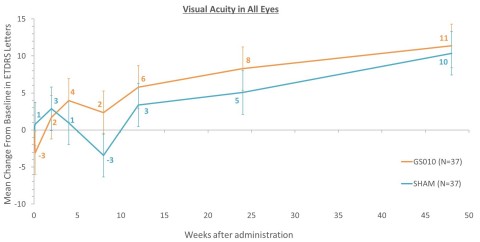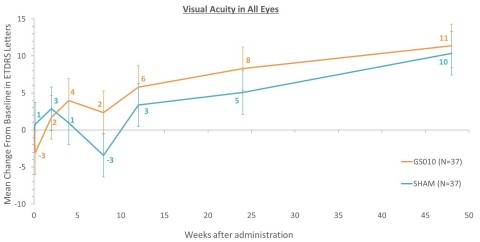PARIS--(BUSINESS WIRE)--Regulatory News:
GenSight Biologics (Paris: SIGHT) (Euronext: SIGHT, ISIN: FR0013183985, PEA-PME eligible), a biopharma company focused on discovering and developing innovative gene therapies for retinal neurodegenerative diseases and central nervous system disorders, today announced topline results from the REVERSE Phase III clinical trial evaluating the safety and efficacy of a single intravitreal injection of GS010 (rAAV2/2-ND4) in 37 subjects whose visual loss due to 11778-ND4 Leber Hereditary Optic Neuropathy (LHON) commenced between 6 and 12 months prior to study treatment.
Topline results further highlight the favorable safety and tolerability profile of GS010, and demonstrate a clinically meaningful improvement of +11 ETDRS letters (-0.218 LogMAR) in treated eyes at 48 weeks as compared to baseline in all 37 patients. Unexpectedly, untreated contralateral eyes (treated with a sham injection) show a similar improvement of +11 ETDRS letters (-0.211 LogMAR). Due to this improvement in untreated eyes, the trial did not meet its primary endpoint, defined as a difference of improvement in visual acuity in GS010-treated eyes compared to sham-treated eyes at 48 weeks.
The improvement of visual acuity in sham-treated eyes was unexpected based on the natural history of LHON, for which partial spontaneous recovery is reported in only 8 to 22% of patients with the G11778 ND4 mutation (Lam et al. 2014, Riordan-Eva et al. 1995). “This meaningful improvement of untreated eyes observed at week 48 was totally unexpected given what is known and has been published about the natural history of this devastating disease. We will continue to analyze the data to better understand our results, but they suggest that GS010 benefits both eyes in a way that is still to be understood,” commented Bernard Gilly, Chief Executive Officer of GenSight.
“The fact that structural measures of the retina showed such a large statistical difference with treatment is compelling and objective evidence that this gene therapy protects the integrity of many retinal ganglion cells from the damage of LHON,” commented Pr. José-Alain Sahel, Director of the Institut de la Vision (Sorbonne-Universités/Inserm/CNRS), Paris, Chairman of the Department of Ophthalmology at Centre Hospitalier National d'Ophtalmologie des XV-XX, Paris, Professor and Chairman of the Department of Ophthalmology at University of Pittsburgh School of Medicine and Medical Center, and co-founder of GenSight Biologics.
The objectively measured endpoints were the effects of GS010 on parameters measured with high resolution Spectral-Domain Optical Coherence Tomography (SD-OCT). The critical secondary endpoint of the change in retinal ganglion cell macular volume measured from baseline to week 48 demonstrated a statistically significant difference (p = 0.0189) between all GS010-treated eyes and all sham-treated eyes, with untreated eyes losing 0.038 cubic mm of macular ganglion cell volume while treated eyes preserved their ganglion cell volume (-0.003 cubic mm).
The secondary endpoint of change in thickness of the temporal quadrant and papillomacular bundle of the retinal nerve fiber layer from baseline to week 48 demonstrated a large statistically significant difference (p = 0.0359) between all GS010-treated eyes and all sham-treated eyes, with untreated eyes showing a loss of 3.4 μm while treated eyes showed a limited loss of 0.6 μm.
"Preliminary optical coherence tomography [OCT] results from the REVERSE trial indicate that the biological targets of the mitochondrial DNA gene therapy have been successfully engaged in the treated eye compared to the untreated eye. The bottom line: we have excellent news for LHON patients and their families about their vision, which is remarkable for a previously untreatable disease," commented Dr. Robert C. Sergott, Director, Wills Eye Hospital, Neuro-Ophthalmology and Director, William H. Annesley, Jr, EyeBrain Center, Thomas Jefferson University, Philadelphia, PA.
Based on preliminary analysis of the safety data, GS010 was well tolerated after 48 weeks. The ocular adverse events most frequently reported in the therapy group were mainly related to the injection procedure, except for the occurrence of intraocular inflammation (accompanied by elevation of intraocular pressure in some patients) that is likely related to GS010, and which was responsive to conventional treatment and without sequelae. There were no withdrawals from the trial.
A full assessment of the data is ongoing, and detailed results are expected be presented at a major upcoming medical meeting.
GS010 is currently being investigated in two additional ongoing Phase III trials, RESCUE and REFLECT, while patients in REVERSE continue to be followed for another 4 years. RESCUE is a randomized, double-masked, sham-controlled Phase III trial designed to evaluate the safety and efficacy of a single intravitreal injection of GS010 in subjects affected by LHON with < 6 months of onset of vision loss. GenSight expects to report topline data for RESCUE in the third quarter of 2018. REFLECT is a randomized, double-masked, placebo-controlled Phase III trial evaluating the safety and efficacy of bilateral injections of GS010 in patients with < 1 year of onset of vision loss in LHON. The first patient in REFLECT was treated in March 2018.
The Company will host a conference call today, April 3, 2018, at 6.30pm CET (12.30pm EST), to discuss these topline results.
Conference call dial-in numbers:
877-407-0783 (toll-free
US & Canada)
0 800 912 848 (toll-free France)
+1-412-902-0037
(international)
Webcast:
https://78449.themediaframe.com/dataconf/productusers/SIGHT/mediaframe/23927/indexl.html
A replay of the call and webcast will be available for 6 months, by dialing 877-660-6853 (toll-free US & Canada) or +1-201-612-7415 (international). The conference ID is 13678406.
About GenSight Biologics
GenSight Biologics S.A. is a clinical-stage biopharma company focused on discovering and developing innovative gene therapies for retinal neurodegenerative diseases and central nervous system disorders. GenSight Biologics’ pipeline leverages two core technology platforms, the Mitochondrial Targeting Sequence (MTS) and optogenetics to help preserve or restore vision in patients suffering from blinding retinal diseases. GenSight Biologics’ lead product candidate, GS010, is in Phase III trials in Leber Hereditary Optic Neuropathy (LHON), a rare mitochondrial disease that leads to irreversible blindness in teens and young adults. Using its gene therapy-based approach, GenSight Biologics’ product candidates are designed to be administered in a single treatment to each eye by intravitreal injection to offer patients a sustainable functional visual recovery.
About GS010
GS010 targets Leber Hereditary Optic Neuropathy (LHON) by leveraging a mitochondrial targeting sequence (MTS) proprietary technology platform, arising from research works conducted at the Institut de la Vision in Paris, which, when associated with the gene of interest, allows the platform to specifically address defects inside the mitochondria using an AAV vector (Adeno-Associated Virus). The gene of interest is transferred into the cell to be expressed and produces the functional protein, which will then be shuttled to the mitochondria through specific nucleotidic sequences in order to restore the missing or deficient mitochondrial function.
About Leber Hereditary Optic Neuropathy (LHON)
Leber Hereditary Optic Neuropathy (LHON) is a rare maternally inherited mitochondrial genetic disease, characterized by the degeneration of retinal ganglion cells that results in brutal and irreversible vision loss that can lead to legal blindness, and mainly affects adolescents and young adults. LHON is associated with painless, sudden loss of central vision in the 1st eye, with the 2nd eye sequentially impaired. It is a symmetric disease with poor functional visual recovery. 97% of patients have bilateral involvement at less than one year of onset of vision loss, and in 25% of cases, vision loss occurs in both eyes simultaneously. The estimated incidence of LHON is approximately 1,400 to 1,500 new patients who lose their sight every year in the United States and Europe.
About RESCUE and REVERSE
RESCUE and REVERSE are two separate randomized, double-masked, sham-controlled pivotal Phase III trials designed to evaluate the efficacy of a single intravitreal injection of GS010 (rAAV2/2-ND4) in subjects affected by LHON due to the G11778A mutation in the mitochondrial ND4 gene.
The primary endpoint will measure the difference in efficacy of GS010 in treated eyes compared to sham-treated eyes based on Best Corrected Visual Acuity (BCVA), as measured with the ETDRS at 48 weeks post-injection. The patients’ LogMAR (Logarithm of the Minimal Angle of Resolution) scores, which are derived from the number of letters patients read on the ETDRS chart, will be used for statistical purposes. Both trials have been adequately powered to evaluate a clinically relevant difference of at least 15 ETDRS letters between treated and untreated eyes adjusted to baseline.
The secondary endpoints will involve the application of the primary analysis to best seeing eyes that received GS010 compared to those receiving sham, and to worse seeing eyes that received GS010 compared to those that received sham. Additionally, a categorical evaluation with a responder analysis will be evaluated, including the proportion of patients who maintain vision (< ETDRS 15L loss), the proportion of patients who gain 15 ETDRS letters from baseline and the proportion of patients with Snellen acuity of >20/200. Complementary vision metrics will include automated visual fields, optical coherence tomography, and color and contrast sensitivity, in addition to quality of life scales, bio-dissemination and the time course of immune response.
The trials are conducted in parallel, in 37 subjects for REVERSE and 39 subjects for RESCUE, in 7 centers across the United States, the UK, France, Germany and Italy. Topline results of RESCUE at 48 weeks are expected in Q3 2018.
ClinicalTrials.gov Identifiers:
REVERSE: NCT02652780
RESCUE:
NCT02652767
About REFLECT
REFLECT is a multi-center, randomized, double-masked, placebo-controlled study to evaluate the safety and efficacy of bilateral injections of GS010 in subjects with LHON due to the NADH dehydrogenase 4 (ND4) mutation.
The trial is planned to enroll 90 patients with an onset of vision loss up to 1 year in duration, and will be conducted in multiple centers in Europe and in the US.
In the active arm, GS010 will be administered as a single intravitreal injection to both eyes of each subject. In the placebo arm, GS010 will be administered as a single intravitreal injection to the first affected eye, while the fellow eye will receive a placebo injection.
The primary endpoint for the REFLECT trial is the BCVA reported in LogMAR at 1-Year post-treatment in the second affected/not yet affected eye. The change from baseline in second affected/not yet affected eyes receiving GS010 and placebo will be the primary response of interest. The secondary efficacy endpoints include: BCVA reported in LogMAR at 2-Years post-treatment in the second affected/not yet affected eye compared to both placebo and the first affected eye receiving GS010, OCT, color and contrast sensitivity and quality of life scales. The first subject was treated in March 2018.
ClinicalTrials.gov Identifiers:
REFLECT: NCT03293524




